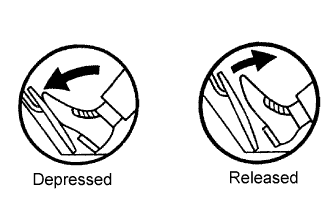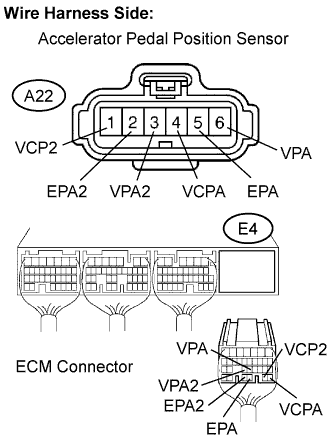READ VALUE USING INTELLIGENT TESTER (ACCEL SENS. NO.1 VOLT % AND ACCEL SENS. NO.2 VOLT %)
CHECK HARNESS AND CONNECTOR (ACCELERATOR PEDAL POSITION SENSOR - ECM)
INSPECT ECM (VCPA AND VCP2 VOLTAGE)
REPLACE ACCELERATOR PEDAL ROD ASSEMBLY
DTC P2120 Throttle / Pedal Position Sensor / Switch "D" Circuit |
DTC P2122 Throttle / Pedal Position Sensor / Switch "D" Circuit Low Input |
DTC P2123 Throttle / Pedal Position Sensor / Switch "D" Circuit High Input |
DTC P2125 Throttle / Pedal Position Sensor / Switch "E" Circuit |
DTC P2127 Throttle / Pedal Position Sensor / Switch "E" Circuit Low Input |
DTC P2128 Throttle / Pedal Position Sensor / Switch "E" Circuit High Input |
DTC P2138 Throttle / Pedal Position Sensor / Switch "D" / "E" Voltage Correlation |
DESCRIPTION
- HINT:
- This is the repair procedure for the accelerator pedal position sensor.
- This electrical throttle system does not use a throttle cable.
- This accelerator pedal position sensor is a non-contact type.
In the accelerator pedal position sensor, the voltage applied to pedal terminals VPA and VPA2 of the ECM changes between 0 V and 5 V in proportion to the opening angle of the accelerator pedal. The VPA is a signal to indicate the actual accelerator pedal opening angle which is used for the engine control, and the VPA2 is a signal to indicate the information about the opening angle which is used for detecting malfunctions. The ECM judges the current opening angle of the accelerator pedal using signals from terminals VPA and VPA2, and the ECM controls the throttle motor based on these signals.

| DTC No. | DTC Detection Condition (All of following are 1 trip detection logic) | Trouble Area |
| P2120 | Condition (a) continues for 0.5 sec. or more: (a) VPA is 0.4 V or less (b) VPA is 4.8 V or more |
|
| P2122 | VPA is 0.4 V or less for 0.5 sec. or more when VPA2 output indicate accelerator pedal is opened |
|
| P2123 | Condition (a) continues for 2.0 sec. or more: (a) VPA is 4.8 V or more |
|
| P2125 | Condition (a) or (b) continues for 0.5 sec. or more: (a) VPA2 is 1.2 V or less (b) VPA2 is 4.8 V or more |
|
| P2127 | VPA2 is 1.2 V or less for 0.5 sec. or more when VPA output indicates accelerator pedal is opened |
|
| P2128 | Conditions (a) and (b) continue for 2.0 sec. or more: (a) VPA2 is 4.8 V or more (b) VPA is 0.4 V or more and VPA is 3.45 V or less |
|
| P2138 | Condition (a) or (b) continues for 2.0 sec. or more: (a) Difference between VPA and VPA2 is 0.02 V or less (b) VPA is 0.4 V or less and VPA2 is 1.2 V or less |
|
WIRING DIAGRAM

INSPECTION PROCEDURE
- NOTICE:
- After replacing the ECM, the new ECM needs registration (Toyota Fortuner RM0000012XK030X.html) and initialization (Toyota Fortuner RM0000012X2005X.html).
- HINT:
- Read freeze frame data using the intelligent tester. Freeze frame data records the engine condition when malfunctions are detected. When troubleshooting, freeze frame data can help determine if the vehicle was moving or stationary, if the engine was warmed up or not, and other data from the time the malfunction occurred.
| 1.READ VALUE USING INTELLIGENT TESTER (ACCEL SENS. NO.1 VOLT % AND ACCEL SENS. NO.2 VOLT %) |
Connect the intelligent tester to the DLC3.
 |
Turn the ignition switch ON and turn the tester ON.
Enter the following menus: Powertrain / Engine / Data List / Accel Sens. No.1 Volt % and Accel Sens. No.2 Volt %.
Read the values.
- Standard voltage:
Accelerator Pedal Operation Accel Sens. No.1 Volt % Accel Sens. No.2 Volt % Released 8 to 28% 30 to 55% Depressed 51 to 86% 73 to 98%
|
| ||||
| NG | |
| 2.CHECK HARNESS AND CONNECTOR (ACCELERATOR PEDAL POSITION SENSOR - ECM) |
Disconnect the A22 sensor connector.
 |
Disconnect the E4 ECM connector.
Measure the resistance of the wire harness side connectors.
- Standard resistance (Check for open):
Tester Connection Specified Condition VCP2 (A22-1) - VCP2 (E4-27) Below 1 Ω EPA2 (A22-2) - EPA2 (E4-29) Below 1 Ω VPA2 (A22-3) - VPA2 (E4-23) Below 1 Ω VCPA (A22-4) - VCPA (E4-26) Below 1 Ω EPA (A22-5) - EPA (E4-28) Below 1 Ω VPA (A22-6) - VPA (E4-22) Below 1 Ω
- Standard resistance (Check for short):
Tester Connection Specified Condition VCP2 (A22-1) or VCP2 (E4-27) - Body ground 10 kΩ or higher EPA2 (A22-2) or EPA2 (E4-29) - Body ground 10 kΩ or higher VPA2 (A22-3) or VPA2 (E4-23) - Body ground 10 kΩ or higher VCPA (A22-4) or VCPA (E4-26) - Body ground 10 kΩ or higher EPA (A22-5) or EPA (E4-28) - Body ground 10 kΩ or higher VPA (A22-6) or VPA (E4-22) - Body ground 10 kΩ or higher
|
| ||||
| OK | |
| 3.INSPECT ECM (VCPA AND VCP2 VOLTAGE) |
Disconnect the A22 sensor APP connector.
 |
Turn the ignition switch ON.
Measure the voltage between the terminals of the ECM connector.
- Standard voltage:
Tester Connection Specified Condition VCPA (E4-26) - EPA (E4-28) 4.5 to 5.5 V VCP2 (E4-27) - EPA2 (E4-29)
|
| ||||
| OK | |
| 4.REPLACE ACCELERATOR PEDAL ROD ASSEMBLY |
Replace accelerator pedal rod assembly (Toyota Fortuner RM0000013ZF006X.html).
| NEXT | |
| 5.CHECK IF OUTPUT DTC RECURS |
Connect the intelligent tester to the DLC3.
Turn the ignition switch ON and turn the tester ON.
Clear DTCs (Toyota Fortuner RM0000012WY00LX.html).
Start the engine.
Allow the engine to idle for 15 seconds.
Enter the following menus: Powertrain / Engine / DTC.
Read the DTC.
- Result:
Display (DTC output) Proceed to P2120, P2122, P2123, P2125, P2127, P2128, or P2138 is output again A No output B
|
| ||||
| A | ||
| ||